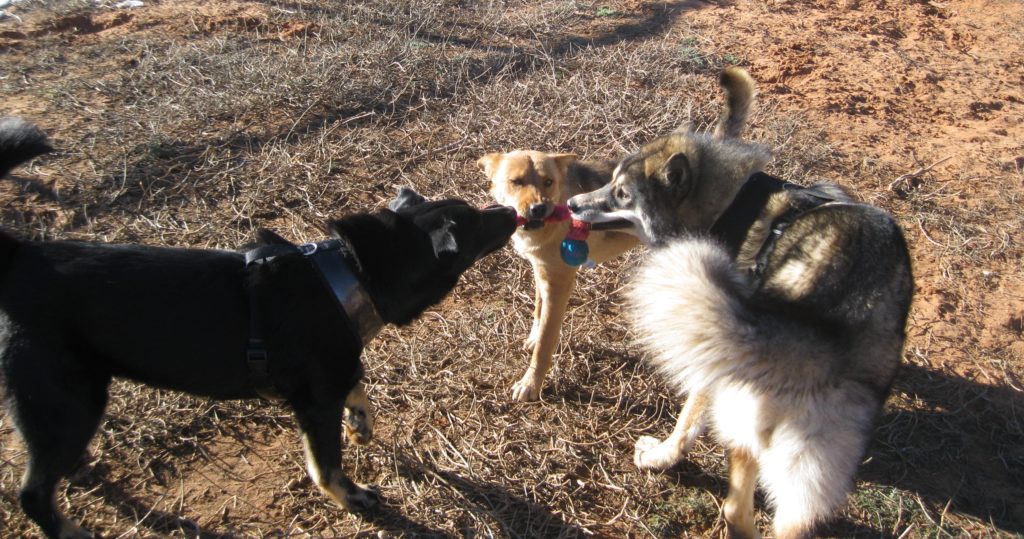When one or more of the following behaviors/body postures is observed in animals, it often indicates anxiety and stress. The context of the behavior is an important clue to whether the behavior is stress related or due to another stimulus. When looking at stress signals, remember that stress-like behavior can also be indicative of other concerns, such as a medical problem, or it may be a behavior that has become a habit.
Stress is dynamic. It changes from moment to moment and within each new situation. Levels of stress can vary dramatically from animal to animal and situation to situation. However, not all stress is counter-productive. Small amounts of stress can enhance awareness and performance.
Rapid shallow or deep forceful panting: Panting is normal for dogs that have been exercising or are hot. So-called “normal” panting is done with deeper respirations, with a relaxed tongue. When a stressed dog pants, the lips will be pulled back in a side grin, causing furrows in the skin under the eyes and on the forehead. Panting is also seen in cats. Cats may pant when overheated, stressed or highly aroused in play or fighting.
Lack of focus or attention: If your dog fails to respond to known cues, he may simply be distracted by a stimulus such as a squirrel. He may also be stressed. When stressed, the dog is likely not ignoring you; he simply cannot respond to you. He may hear you perfectly well, but his mind is unable to process the information. (Sometimes, we find ourselves so stressed that even the simplest task is impossible for us to do!) This is the same for cats.
Avoidance: Animals may try to hide, turn away, shut down, or run and dodge from us.
Sweaty paws: Dogs get sweaty paws when stressed in the same manner that people get sweaty palms. This reaction is often visible on hardwood floors or metal tables at the vet.
This can also be seen in cats.
Yawning: Yawning is one of the most common signs of stress. Stress-related yawns will be more intense than “sleepy” yawns. The dog may be in an excited vs. relaxed state when yawning.
Increased frequency of urination or defecation: A stressed body will try to force fluids out of the system. Some “house training” issues that owners report are stress related. Inappropriate spontaneous voiding is an indicator of extreme stress.
Vomiting and diarrhea: The digestive system is often the first system to react to stress. Persistent vomiting and or diarrhea are signs are illness.
Drooling: Drooling usually indicates stress in the absence of a mouth injury or in anticipation of food.
Stretching: Stretching is a way to relax the muscles that tense from stress. This type of stretching is not related to sleeping or from staying in one position for a long period of time.
Shaking: You may see a full-body shake when the dog is not wet.
Confusion: Strange, abnormal, or confused behavior can be the result of stress. Exercise caution when interpreting this behavior as it can also indicate a medical problem like a seizure or diabetic emergency.
Self-mutilation: Tail chewing, paw licking and chewing or sucking on the flank may be signs of stress, although the behaviors may have medical origins.
Excessive grooming: Common sites for excessively licking are paws, legs, flanks and genital areas.
Sleeping excessively: Every animal has a different energy level, so excessive sleeping may be difficult to recognize. This is a sign of chronic stress, shutting down and serotonin depletion.
Immune system disorder: Stress lowers the immune system response to diseases and allergies.
Excessive thirst: Increased drinking without a medical or exercise-related cause. This could be a sign of redirected frustration or an obsessive disorder.
Eating less or more: Changes in eating behavior may signal anxiety, injury or illness.
Stiffness: Tension can create a stiff gait and tail movement.
Whining: Due to anxiety or excitability.
Low body carriage: Moving low to the ground is likely exhibiting stress. Sitting hunched with head lowered.
Mouthiness: Mouthiness may range from gentle mouthing to snapping or biting.
Hyperactivity: Stress may trigger a defense mechanism that can look frantic. The animal will eventually shut down when his system is drained.
Displacement Behaviors: These behaviors may be triggered by conflict, anxiety, uneasiness, and uncertainty. Common responses that can be misinterpreted:
Lip licking
Licking nose
Yawning
Sniffing the ground
Licking or sniffing the urogenital area
Scratching
Shaking off as if wet
Blinking
Lip smack
Leash biting
Redirecting (“turning on” biting the person or animal someone or thing nearest to them)
Calming/Appeasement Signals: Some people believe that all animals use calming signals with each other to defuse stressful situations. These signals may have a communicative function to reduce the arousal level of the other animal or calm the animal down.
Turning the head away or averting the eyes
Turning completely away
Sniffing at the ground (very common)
Quick (often lizard-like) licking of the lips
Freezing in place
Moving excruciatingly slowly
Sitting or lying down
Play-bow position
Yawning
Tap Out (rolling or flipping over onto back, often belly exposed)
